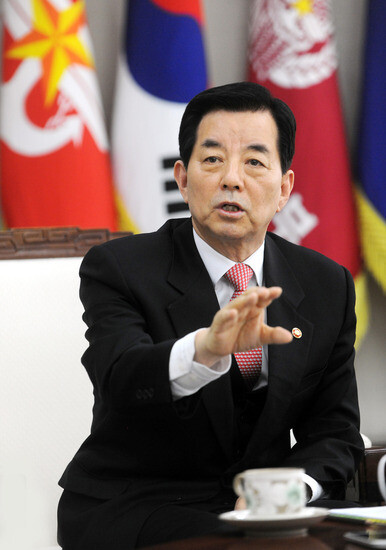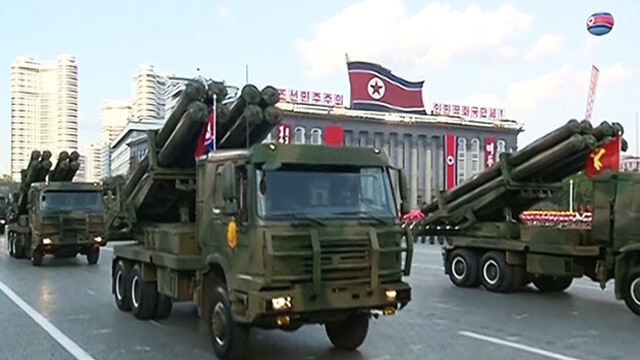hankyoreh
Links to other country sites 다른 나라 사이트 링크
Defense Minister: North Korea has new rocket launcher capable of striking deep

South Korea’s defense minister predicted on Apr. 6 that North Korea could have a new 300-mm multiple rocket launcher (MRL) capable of striking as deep as Chungcheong Province in place by the end of this year.
In press conference with reporters covering the Ministry of National Defense that day, Minister Han Min-koo said the North’s several recent tests of the MRL “suggest development is almost complete.”
The 300-mm MRL has a maximum range of 200 km, which would allow strikes against US Forces Korea (USFK) bases in Osan and Pyeongtaek, as well as the Army, Navy, and Air Forces headquarters at the Gyeryongdae complex in South Chungcheong Province. Called the KN-09, the MRL was first observed by South Korean and US military authorities in 2013. North Korea conducted launches on Mar. 2, Mar. 21, and Mar. 29 this year, and announced on Mar. 22 that it had completed its “final test fire.”
Han also said the MRL’s precision had been improved with the attachment of a guidance system. Referring to a Mar. 22 photograph in North Korea’s Rodong Sinmun newspaper showing a MRL rocket making a precision strike against a target, Han said, “It appears that they did not simply develop a rocket, but also attached a guidance device.”
Han went on to say the South Korean military was “amply capable” of responding to the threat posed by the 300-mm MRL.
“The South Korean military possesses capabilities for monitoring and detecting [the MRL] in real time with unmanned aerial vehicles (UAVs) and artillery hunting radar, and for destroying and neutralizing it will Air Force strength, surface-to-surface missiles, and ground firepower,” he explained.

Han also discussed the North’s nuclear weapon miniaturization technology.
“Significant development has been achieved, but there is no basis for saying it has acquired miniaturization technology,” he said.
Regarding the North‘s solid-fuel rocket testing, Han noted that propulsion unit develop involves five stages of missile design, propellant development and production, combustion testing, system integration and flight testing.
“North Korea is currently at the third stage, which is combustion testing,” he said. He also described the North’s intercontinental ballistic missile reentry testing as being “at a rudimentary level.”
Han voiced a cautious stance on the trilateral defense and security cooperation agreed upon with the US and Japan at a summit in Washington, DC, on Mar. 31.
“It is necessary in military terms, but there may be differences in perspective among the three parties on what level of cooperation we should engage in and in what areas,” he said.
Han was particularly hesitant on the matter of South Korea and Japan signing a General Security of Military Information Agreement (GSOMIA).
“The conditions and environment would need to be established first,” he said.
Meanwhile, a report published on Apr. 5 by the US Institute for Science and International Security (ISIS) quoted US government authorities observing the situation at North Korea’s Yongbyon nuclear facility as saying reprocessing of spent nuclear fuel may have begun at its five-megawatt reactor.
“In total, the 5-megawatt reactor could have produced an estimated 5-7 kilograms of weapons-grade plutonium,” the report said of North Korea’s repeated stopping and starting of operations at the reaction since mid-2013.
“This is enough plutonium for one to three nuclear weapons,” it added.
By Park Byong-su, senior staff writer and Yi Yong-in, Washington correspondent
Please direct questions or comments to [english@hani.co.kr]

Editorial・opinion
![[Column] Season 2 of special prosecutor probe may be coming to Korea soon [Column] Season 2 of special prosecutor probe may be coming to Korea soon](https://flexible.img.hani.co.kr/flexible/normal/500/300/imgdb/original/2024/0426/3317141030699447.jpg) [Column] Season 2 of special prosecutor probe may be coming to Korea soon
[Column] Season 2 of special prosecutor probe may be coming to Korea soon![[Column] Park Geun-hye déjà vu in Yoon Suk-yeol [Column] Park Geun-hye déjà vu in Yoon Suk-yeol](https://flexible.img.hani.co.kr/flexible/normal/500/300/imgdb/original/2024/0424/651713945113788.jpg) [Column] Park Geun-hye déjà vu in Yoon Suk-yeol
[Column] Park Geun-hye déjà vu in Yoon Suk-yeol- [Editorial] New weight of N. Korea’s nuclear threats makes dialogue all the more urgent
- [Guest essay] The real reason Korea’s new right wants to dub Rhee a founding father
- [Column] ‘Choson’: Is it time we start referring to N. Korea in its own terms?
- [Editorial] Japan’s rewriting of history with Korea has gone too far
- [Column] The president’s questionable capacity for dialogue
- [Column] Are chaebol firms just pizza pies for families to divvy up as they please?
- [Column] Has Korea, too, crossed the Rubicon on China?
- [Correspondent’s column] In Japan’s alliance with US, echoes of its past alliances with UK
Most viewed articles
- 1‘We must say no’: Seoul defense chief on Korean, USFK involvement in hypothetical Taiwan crisis
- 2After election rout, Yoon’s left with 3 choices for dealing with the opposition
- 3Why Kim Jong-un is scrapping the term ‘Day of the Sun’ and toning down fanfare for predecessors
- 4AI is catching up with humans at a ‘shocking’ rate
- 5[Editorial] Korea’s surprise Q1 growth requires objective assessment, not blind fanfare
- 6Noting shared ‘values,’ Korea hints at passport-free travel with Japan
- 7Two factors that’ll decide if Korea’s economy keeps on its upward trend
- 8Gangnam murderer says he killed “because women have always ignored me”
- 9South Korea officially an aged society just 17 years after becoming aging society
- 10The dream K-drama boyfriend stealing hearts and screens in Japan